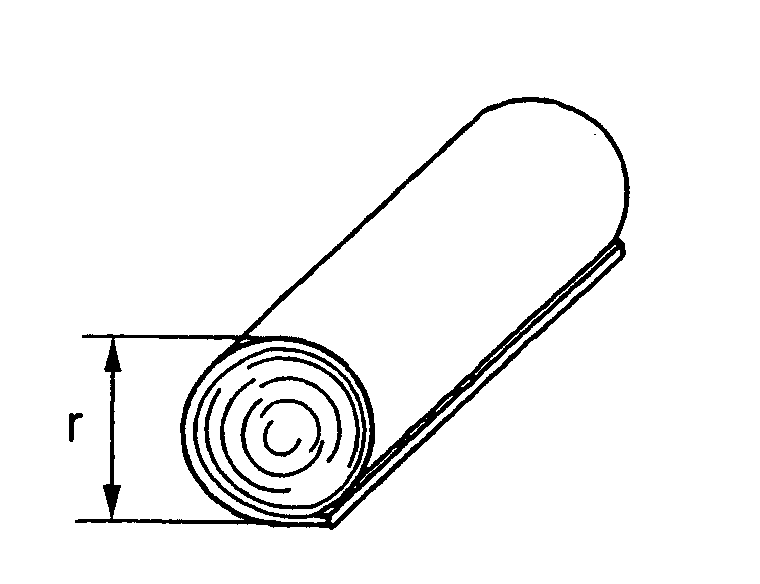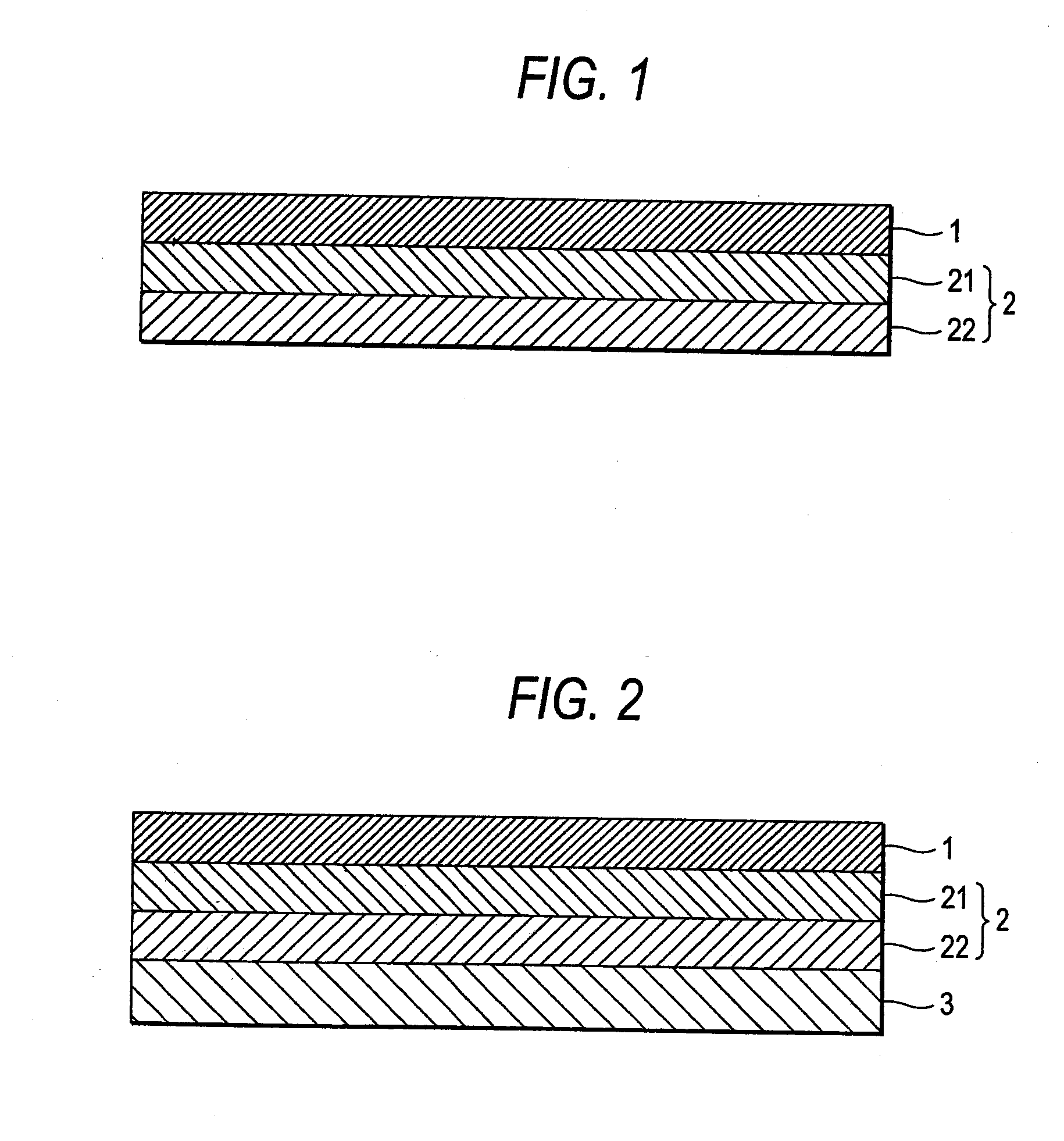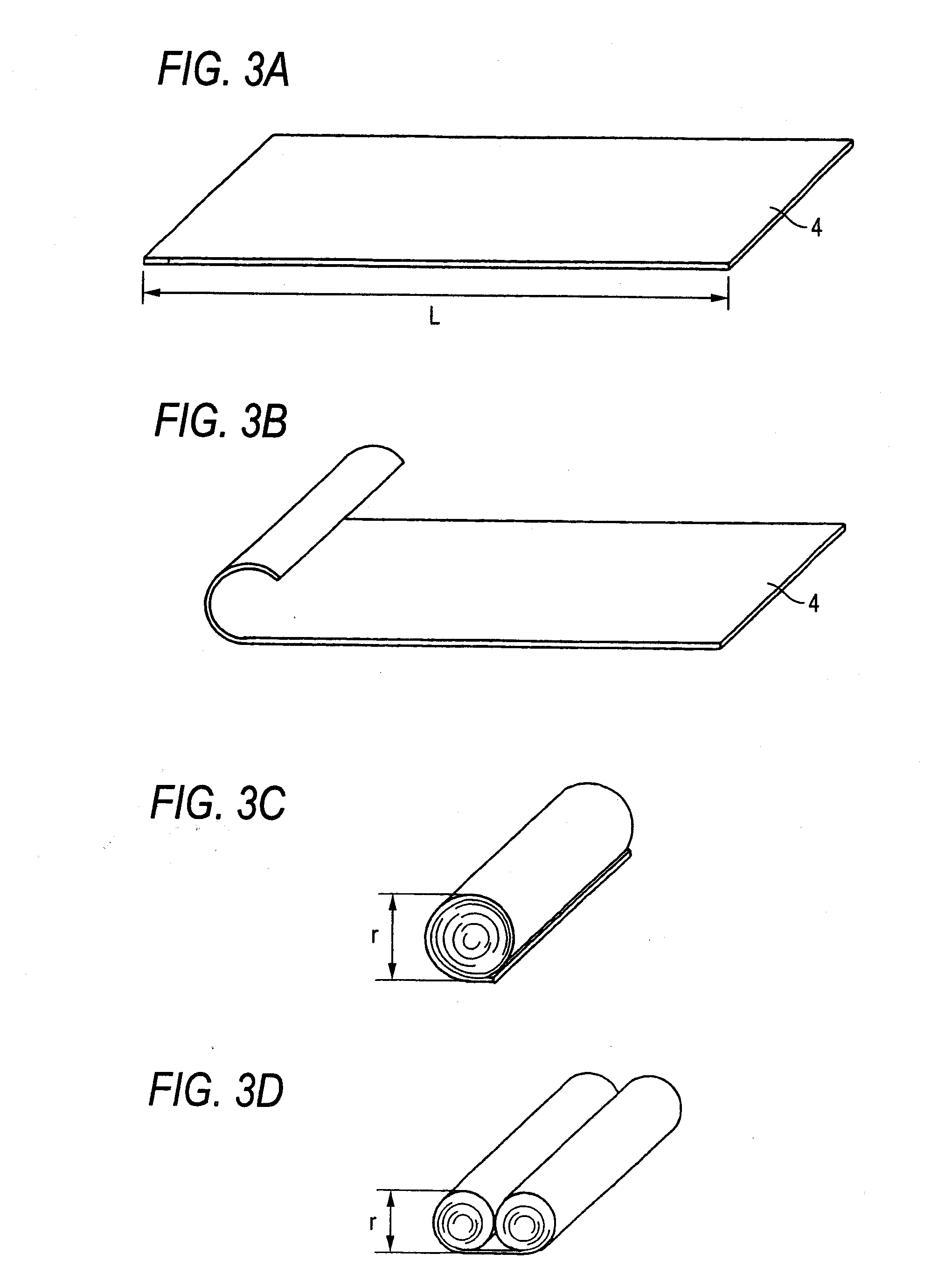Self-rolling laminated sheet and self-rolling pressure-sensitive adhesive sheet
a self-rolling, adhesive sheet technology, applied in the direction of film/foil adhesives, transportation and packaging, synthetic resin layered products, etc., can solve the problems of easy cracking, thin wafers are very brittle and easily cracked, and the edge chipping is difficult to peel, so as to reduce the contamination of the adherend
- Summary
- Abstract
- Description
- Claims
- Application Information
AI Technical Summary
Benefits of technology
Problems solved by technology
Method used
Image
Examples
production example 1
Production of Energy Ray-Curable Pressure-Sensitive Adhesive Layer (1)
[0133]In an acrylic polymer, 80% of the hydroxyl group derived from 2-hydroxyethyl acrylate of an acrylic polymer [obtained by copolymerizing a composition: butyl acrylate ethyl acrylate:2-hydroxyethylacrylate=50:50:20 (weight ratio)] was bound to methacryloyloxyethyl isocyanate (2-isocyanatoethyl methacrylate), to produce an acrylic polymer having a methacrylate group in the side chain. 100 parts by weight of this acrylic polymer having a methacrylate group in the side chain was mixed with 50 parts by weight of pentaerytyritol tetraacrylate as a compound containing two or more functional groups having a carbon-carbon double bond, 6 parts by weight of a photoinitiator (manufactured by Ciba Geigy, Ltd.), trade name “Irgacure 184”), 1.5 parts by weight of a crosslinking agent (trade name “Coronate L”), and 40 parts by weight of a thickening agent (manufactured by Soken Chemical & Engineering Co., Ltd.), trade name “...
production example 2
Production of Energy Ray-Curable Pressure-Sensitive Adhesive Layer (2)
[0135]In an acrylic polymer, 80% of the hydroxyl group derived from 2-hydroxyethyl acrylate of an acrylic polymer [obtained by copolymerizing a composition: butyl acrylate:ethyl acrylate:2-hydroxyethylacrylate=50:50:20 (weight ratio)] was bound to methacryloyloxyethyl isocyanate (2-isocyanatoethyl methacrylate), to produce an acrylic polymer having a methacrylate group in the side chain. 100 parts by weight of this acrylic polymer having a methacrylate group in the side chain was mixed with 100 parts by weight of “Ultraviolet UV1700” (trade name) manufactured by Nippon Synthetic Chemical Industry Co., Ltd., as a compound containing two or more functional groups having a carbon-carbon double bond, 3 parts by weight of a photoinitiator (manufactured by Ciba Geigy, Ltd.), trade name “Irgacure 184”), and 1.5 parts by weight of a crosslinking agent (trade name “Coronate L”), to produce an energy ray-curable pressure-se...
production example 3
Production of Energy Ray-Curable Pressure-Sensitive Adhesive Layer (3)
[0137]In an acrylic polymer, 80% of the hydroxyl group derived from 2-hydroxyethyl acrylate of an acrylic polymer [obtained by copolymerizing a composition: butyl acrylate:ethyl acrylate:2-hydroxyethylacrylate=50:50:20 (weight ratio)] was bound to methacryloyloxyethyl isocyanate (2-isocyanatoethyl methacrylate), to produce an acrylic polymer having a methacrylate group in the side chain. 100 parts by weight of this acrylic polymer having a methacrylate group in the side chain was mixed with 50 parts by weight of “Ultraviolet UV1700” (trade name) manufactured by Nippon Synthetic Chemical Industry Co., Ltd., as a compound containing two or more functional groups having a carbon-carbon double bond, 3 parts by weight of a photoinitiator (manufactured by Ciba Geigy, Ltd.), trade name “Irgacure 184”), and 1.5 parts by weight of a crosslinking agent (trade name “Coronate L”), to produce an energy ray-curable pressure-sen...
PUM
| Property | Measurement | Unit |
|---|---|---|
| temperature | aaaaa | aaaaa |
| thermal shrinkage rate | aaaaa | aaaaa |
| tensile speed | aaaaa | aaaaa |
Abstract
Description
Claims
Application Information
 Login to View More
Login to View More - R&D
- Intellectual Property
- Life Sciences
- Materials
- Tech Scout
- Unparalleled Data Quality
- Higher Quality Content
- 60% Fewer Hallucinations
Browse by: Latest US Patents, China's latest patents, Technical Efficacy Thesaurus, Application Domain, Technology Topic, Popular Technical Reports.
© 2025 PatSnap. All rights reserved.Legal|Privacy policy|Modern Slavery Act Transparency Statement|Sitemap|About US| Contact US: help@patsnap.com



